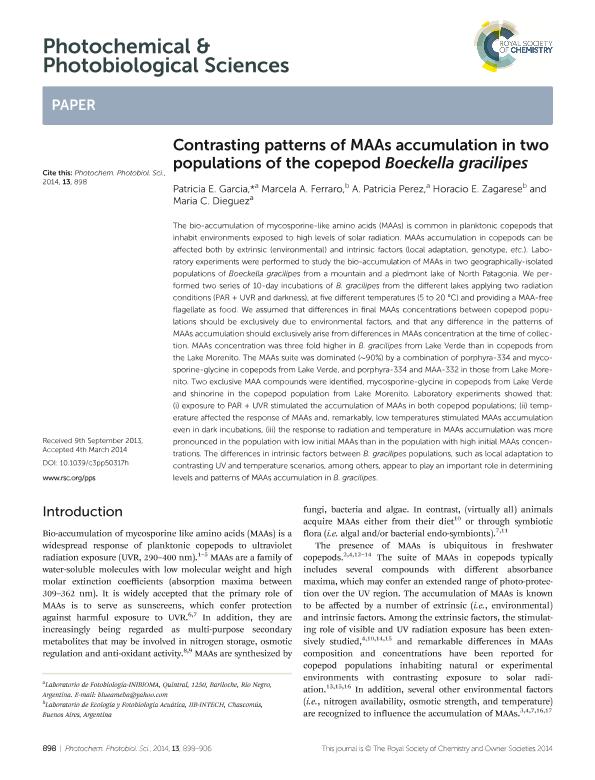Mostrar el registro sencillo del ítem
dc.contributor.author
Garcia, Patricia Elizabeth

dc.contributor.author
Ferraro, Marcela A.
dc.contributor.author
Perez, Alejandra Patricia

dc.contributor.author
Zagarese, Horacio Ernesto

dc.contributor.author
Dieguez, Maria del Carmen

dc.date.available
2017-01-27T21:13:05Z
dc.date.issued
2014
dc.identifier.citation
Garcia, Patricia Elizabeth; Ferraro, Marcela A.; Perez, Alejandra Patricia; Zagarese, Horacio Ernesto; Dieguez, Maria del Carmen; Contrasting patterns of MAAs accumulation in two populations of the copepod Boeckella gracilipes; Royal Society Of Chemistry; Photochemical And Photobiological Sciences; 13; 6; 2014; 898-906
dc.identifier.issn
1474-905X
dc.identifier.uri
http://hdl.handle.net/11336/12139
dc.description.abstract
The bio-accumulation of mycosporine-like amino acids (MAAs) is common in planktonic copepods that inhabit environments exposed to high levels of solar radiation. MAAs accumulation in copepods can be affected both by extrinsic (environmental) and intrinsic factors (local adaptation, genotype, etc.). Laboratory experiments were performed to study the bio-accumulation of MAAs in two geographically-isolated populations of Boeckella gracilipes from a mountain and a piedmont lake of North Patagonia. We performed two series of 10-day incubations of B. gracilipes from the different lakes applying two radiation conditions (PAR + UVR and darkness), at five different temperatures (5 to 20 °C) and providing a MAA-free flagellate as food. We assumed that differences in final MAAs concentrations between copepod populations should be exclusively due to environmental factors, and that any difference in the patterns of MAAs accumulation should exclusively arise from differences in MAAs concentration at the time of collection. MAAs concentration was three fold higher in B. gracilipes from Lake Verde than in copepods from the Lake Morenito. The MAAs suite was dominated (∼90%) by a combination of porphyra-334 and mycosporine-glycine in copepods from Lake Verde, and porphyra-334 and MAA-332 in those from Lake Morenito. Two exclusive MAA compounds were identified, mycosporine-glycine in copepods from Lake Verde and shinorine in the copepod population from Lake Morenito. Laboratory experiments showed that: (i) exposure to PAR + UVR stimulated the accumulation of MAAs in both copepod populations; (ii) temperature affected the response of MAAs and, remarkably, low temperatures stimulated MAAs accumulation even in dark incubations, (iii) the response to radiation and temperature in MAAs accumulation was more pronounced in the population with low initial MAAs than in the population with high initial MAAs concentrations. The differences in intrinsic factors between B. gracilipes populations, such as local adaptation to contrasting UV and temperature scenarios, among others, appear to play an important role in determining levels and patterns of MAAs accumulation in B. gracilipes.
dc.format
application/pdf
dc.language.iso
eng
dc.publisher
Royal Society Of Chemistry

dc.rights
info:eu-repo/semantics/openAccess
dc.rights.uri
https://creativecommons.org/licenses/by-nc-sa/2.5/ar/
dc.subject
Bioaccumulation
dc.subject
Maas
dc.subject
Boeckella Gracilipes
dc.subject.classification
Ecología

dc.subject.classification
Ciencias Biológicas

dc.subject.classification
CIENCIAS NATURALES Y EXACTAS

dc.title
Contrasting patterns of MAAs accumulation in two populations of the copepod Boeckella gracilipes
dc.type
info:eu-repo/semantics/article
dc.type
info:ar-repo/semantics/artículo
dc.type
info:eu-repo/semantics/publishedVersion
dc.date.updated
2016-12-12T14:24:16Z
dc.identifier.eissn
1474-9092
dc.journal.volume
13
dc.journal.number
6
dc.journal.pagination
898-906
dc.journal.pais
Reino Unido

dc.description.fil
Fil: Garcia, Patricia Elizabeth. Consejo Nacional de Investigaciones Científicas y Técnicas. Centro Científico Tecnológico Patagonia Norte. Instituto de Investigación En Biodiversidad y Medioambiente; Argentina
dc.description.fil
Fil: Ferraro, Marcela A.. Consejo Nacional de Investigaciones Científicas y Técnicas. Centro Científico Tecnológico la Plata. Instituto de Investigaciones Biotecnológicas - Instituto Tecnológico Chascomús. Instituto de Investigaciones Biotecnológicas (sede Chascomús); Argentina
dc.description.fil
Fil: Perez, Alejandra Patricia. Consejo Nacional de Investigaciones Científicas y Técnicas. Centro Científico Tecnológico Patagonia Norte. Instituto de Investigación En Biodiversidad y Medioambiente; Argentina
dc.description.fil
Fil: Zagarese, Horacio Ernesto. Consejo Nacional de Investigaciones Científicas y Técnicas. Centro Científico Tecnológico la Plata. Instituto de Investigaciones Biotecnológicas - Instituto Tecnológico Chascomús. Instituto de Investigaciones Biotecnológicas (sede Chascomús); Argentina
dc.description.fil
Fil: Dieguez, Maria del Carmen. Consejo Nacional de Investigaciones Científicas y Técnicas. Centro Científico Tecnológico Patagonia Norte. Instituto de Investigación En Biodiversidad y Medioambiente; Argentina
dc.journal.title
Photochemical And Photobiological Sciences

dc.relation.alternativeid
info:eu-repo/semantics/altIdentifier/doi/http://dx.doi.org/10.1039/c3pp50317h
dc.relation.alternativeid
info:eu-repo/semantics/altIdentifier/url/http://pubs.rsc.org/en/Content/ArticleLanding/2014/PP/c3pp50317h#!divAbstract
Archivos asociados
